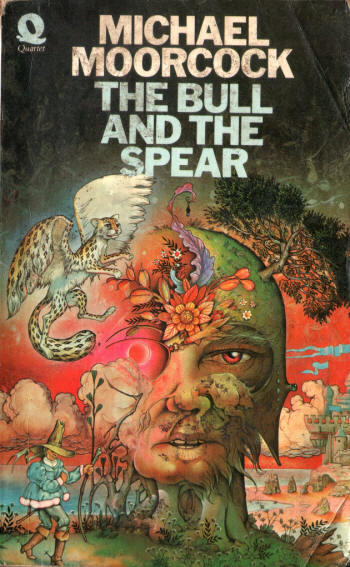|
Patrick
Woodroffe: Mythopoieken
Marcus Williamson on the late Cornwall-based fantasy artist
 Patrick
Woodroffe was a prolific artist whose fantastical illustrations adorned
paintings, innumerable science-fiction books, record sleeves and
posters. He likened his work to the "cartography of a nowhere-land", a
picture map of a "world enclosed within the walls of his skull, a world
confined to tiny electric pathways between billions of minute brain
cells". Patrick
Woodroffe was a prolific artist whose fantastical illustrations adorned
paintings, innumerable science-fiction books, record sleeves and
posters. He likened his work to the "cartography of a nowhere-land", a
picture map of a "world enclosed within the walls of his skull, a world
confined to tiny electric pathways between billions of minute brain
cells".
Woodroffe was born in Halifax in 1940, the second son of Beatrice and
Daniel Woodroffe, an electrical engineer. The family moved several times
during his childhood, eventually settling at Coalbrookdale, Shropshire.
He studied French and German at Leeds University.
He married his childhood sweetheart, Jean Pardoe, in 1964. They
travelled to Cornwall on honeymoon, staying on The Lizard. His daughter,
Rosie Woodroffe, told The Independent, "They loved the area so much
they decided not to leave and within three weeks of marriage had found
jobs (he as a teacher of French and German, she as an optician) and a
flat in Falmouth... So, essentially in this, their 50th year of
marriage, they were still on honeymoon." His artistic influences
came, he said, from "...the work of Salvador Dali, the Viennese
school of 'fantastic realism', and above all the work of Dutch and
Flemish so-called 'primitives' of the Middle Ages and Renaissance."
An early painting, Birth of Animated Nature (1965), shows clearly
these inspirations from Brueghel and especially from Bosch's The
Garden of Earthly Delights.
Having initially imitated the surrealist master in his drawings, he soon
arrived at a style of his own. "Gradually I started to invent for
myself, to comment in my own words on the beauties and follies around
me... I followed my first drawings with a series entitled Conflict which
attempted to understand the
 painful
necessity of death and destruction." The result was an exhibition in
1966 at the Institute of Contemporary Arts on The Mall, London, a
selection from this series, chosen by the surrealist artist Roland
Penrose. painful
necessity of death and destruction." The result was an exhibition in
1966 at the Institute of Contemporary Arts on The Mall, London, a
selection from this series, chosen by the surrealist artist Roland
Penrose.
By 1972 Woodroffe had abandoned teaching to concentrate full-time on his
illustration work. "Evan Anthony, at that time art critic for The
Spectator, offered me an exhibition at his Covent Garden Gallery,"
he recalled. "The show was a great success, and was twice extended. I
sold quite a number of paintings and drawings and several hundred
etchings."
As a result of this exhibition, Woodroffe was commissioned by Pan Books'
art director David Larkin to create covers for around 100
science-fiction and fantasy books over the next few years, including
works by Robert Heinlein and Arthur C. Clarke. A similar commission led
to Woodroffe producing jackets for almost all Michael Moorcock's
publications, through Quartet Books. He noted of Moorcock's work that
"...nothing is impossible, nothing unacceptable. His monsters, machines
and improbable worlds do not need to be feasible" – observations
that could apply equally well to the artist's own landscapes of the
imagination.
During the 1970s and '80s he was one of the artists in most demand for
this genre of illustration. Working with the musician Dave Greenslade,
Woodroffe illustrated a book to accompany The Pentateuch of the
Cosmogony: The Birth and Death of a World (1979), a concept double
album imagining an alien Book of Genesis, which sold more than 50,000
copies. He also created album covers for Judas Priest's LP Sad Wings
of Destiny (1976) and for The Sentinel (1984), by progressive
rock band Pallas.
In the early 1990s his career took a new direction when a retrospective
was held at the Chateau de Gruyères in Switzerland, covering the walls
of the former Prison Tower, and attracting 150,000 visitors. A permanent
 exhibition
of his work now resides there. Following the success of the 1992
exhibition, he had since shown widely in Switzerland, Germany and
France. exhibition
of his work now resides there. Following the success of the 1992
exhibition, he had since shown widely in Switzerland, Germany and
France.
Four of his works were selected for an exhibition at the National
Maritime Museum in Falmouth in 2002. A one-man show, Patrick Woodroffe –
Master of Fantasy, followed at the town's art gallery three years later.
In 2009 Falmouth acquired Mountain Dragons of British Columbia
(1977 - pictured below), a piece as notable for its content as for its
magnificent altarpiece-like frame and alpine-style shutters, designed by
Woodroffe and commissioned by the gallery's director Brian Stewart
(Independent obituary, 10 February 2011). Seven years ago Woodroffe had
been diagnosed with Pick's disease, a form of dementia. His friend, the
artist Paul Spooner, told The Independent, "Even though his memory
for names had pretty much gone, he was able to find his way to places
with ease. His heyday was the 70s and 80s, making meticulous paintings
of impossible scenes and objects... He was an extraordinary artist with
a Renaissance artist's capacity for creative techniques."
In the epilogue to his book Mythopoeikon, Woodroffe wrote: "And when
you have finished your little flight around the park, you who would have
walked around the world, bequeath to your children your myths and your
fantasies, that the richness of human experience may become a book for
all to read, a testament from the dying eye, a picture of the inside of
the dying brain, a Mythopoeikon."

Patrick Woodroffe, artist: born 27
October 1940; married 1964 Jean Pardoe (one son, one daughter); died
Truro 10 May 2014.
|